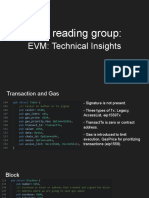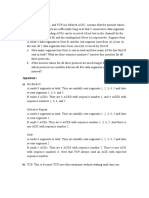0% found this document useful (0 votes)
26 views10 pagesCBT Unit - 4 Notes
Hyperledger Fabric is an open-source, permissioned blockchain framework designed for enterprise use, featuring modular architecture, high scalability, and privacy. Its architecture includes components like peers, chaincode, ledger, ordering service, membership service provider, and channels, enabling customizable and secure transactions. The Ethereum Virtual Machine (EVM) is a decentralized computation engine that executes smart contracts on the Ethereum blockchain, ensuring consistent and secure execution across nodes with a stack-based architecture and gas metering.
Uploaded by
viswaaeswaranCopyright
© © All Rights Reserved
We take content rights seriously. If you suspect this is your content, claim it here.
Available Formats
Download as PDF, TXT or read online on Scribd
0% found this document useful (0 votes)
26 views10 pagesCBT Unit - 4 Notes
Hyperledger Fabric is an open-source, permissioned blockchain framework designed for enterprise use, featuring modular architecture, high scalability, and privacy. Its architecture includes components like peers, chaincode, ledger, ordering service, membership service provider, and channels, enabling customizable and secure transactions. The Ethereum Virtual Machine (EVM) is a decentralized computation engine that executes smart contracts on the Ethereum blockchain, ensuring consistent and secure execution across nodes with a stack-based architecture and gas metering.
Uploaded by
viswaaeswaranCopyright
© © All Rights Reserved
We take content rights seriously. If you suspect this is your content, claim it here.
Available Formats
Download as PDF, TXT or read online on Scribd
/ 10


































































































